The Awakening
I never really saw myself as one who kept abreast of historical events that involved racial inequity or the politics associated with it. That is, and I am embarrassed to say, was not until way into my adult years. Significant points in time were when; you guessed it – when America got its first Black president and the seemingly daily injustices, abuse, and killing of our Black men and women. The latter brought about more proof of the continued outrageous treatment placed upon Black Americans, thanks to social media, and cell phone capabilities to record.
Don’t get me wrong, I’m not saying I was sightless to the injustices, but as these atrocities on and against Black people continued, like everyone else, I was actually seeing it all unfold live before my eyes. One could no longer ignore what was happening. The events became more than just something that you heard or read about, but visible for the world to see – what has always been real; at least for Black America.
Black Americans are mad as hell and we’re not taking it anymore! The fight to bring awareness and solutions to racial injustices is still in the ring. Metaphorically speaking, each round of the message may be presented differently, but after the bell, it’s evident that the goal of the event hasn’t changed over the years. It’s the knockout! Hands raised in the air in victory! However, the fight’s not over.
The Dawn of the Fist
The very early 1970s was the first time I saw the “fist.” It was at the end of my brother’s black plastic afro pick comb. At that time, I didn’t know the reasoning behind the design. Almost 50 years later, I have gained more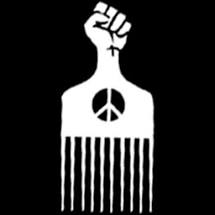 awareness and pride in what it all means. How did I accrue this conscientiousness? I recently watched a documentary entitled With Drawn Arms, that for me, bridges past and present. The documentary uncovers the story behind a critical moment in American history, spawning one of the most iconic images of protest from the past century. Over half a century ago, before Colin Kaepernick took a knee — Tommie Smith, a Black American Gold Olympic medalist, considered to be the fastest man in the world, raised his fist at the 1968 Olympics.
awareness and pride in what it all means. How did I accrue this conscientiousness? I recently watched a documentary entitled With Drawn Arms, that for me, bridges past and present. The documentary uncovers the story behind a critical moment in American history, spawning one of the most iconic images of protest from the past century. Over half a century ago, before Colin Kaepernick took a knee — Tommie Smith, a Black American Gold Olympic medalist, considered to be the fastest man in the world, raised his fist at the 1968 Olympics.
https://www.youtube.com/watch?v=-P54RGFXmHo
The Stand
The first televised Olympics were held in Mexico City. Exciting as that must have been, what was probably most incredible was that the world was able to watch two Black American athletes, Tommie Smith and John Carlos raise their black-gloved fist as the United States National Anthem sounded around the stadium. Sure, I saw pictures of the iconic and historical stance, but I didn’t know the story behind the stand. I just so happened to turn on the TV. A documentary was on and the first image I saw was that of the raised fist! Suddenly, I was drawn in and had to sit down and watch.
And so it begins
The documentary was developed by artist and filmmaker Glen Kaino and co-director Afshin Shahidi who follow Smith as he looks back 50 years to the moment that helped define a movement and changed the course of his life—both personally and professionally. The film presents an awesome and historical significance of the gesture and its relevance today. The documentary focused on the exhibition organized by the High Museum of Art that featured sculptural installations and drawings by Kaino and Smith, and objects from the Tommie Smith archives. Watching as his story unfolded, heartfelt emotions came over me as it often does when seeing the greatness of my people, past and present. At the conclusion of the documentary, which was a stepping stone to the knowledge I had gained, I was eager to learn more. To feed my interest, I researched his-story!
Telling the Story
This was no ordinary story. Although the documentary was about Smith, what unfolded was a tale of two men. In a time of war, assassination, and political and racial tension, Smith and Carlos had come to the ceremony dressed to protest: wearing black socks and no shoes to symbolize African-American poverty, and a black glove to express African-American strength and unity.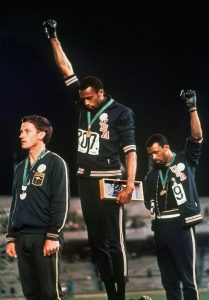 (Smith also wore a scarf, and Carlos beads, in memory of lynching victims). After an extraordinary win, positioned on the highest step in the center of the tri-level podium, receiving his gold medal, and the bronze for Carlos, they proceed to use that platform to take a stand. Making a decision to sacrifice all that they worked for and against all odds to achieve — the two acknowledged something more important to them than sports. They raised their black-gloved fists in protest and response to human rights abuses occurring in apartheid-era South Africa and Rhodesia, to express solidarity with those struggling for civil rights in the United States, and to stand with other disenfranchised people around the world.
(Smith also wore a scarf, and Carlos beads, in memory of lynching victims). After an extraordinary win, positioned on the highest step in the center of the tri-level podium, receiving his gold medal, and the bronze for Carlos, they proceed to use that platform to take a stand. Making a decision to sacrifice all that they worked for and against all odds to achieve — the two acknowledged something more important to them than sports. They raised their black-gloved fists in protest and response to human rights abuses occurring in apartheid-era South Africa and Rhodesia, to express solidarity with those struggling for civil rights in the United States, and to stand with other disenfranchised people around the world.
The Black Power Salute: The Consequences
Now don’t think for a minute that there weren’t any outcries and consequences for Smith and Carlos’ actions. New York Times correspondent Joseph M. Sheehan covered the event. At first, the “incident” passed without much attention in the packed Olympic Stadium. But by the time Sheehan’s observation appeared in print three days later, the event had become front-page news: for politicizing the Games. The end result was suspension and the two medalists were forced to leave Mexico.
The raising of the fist was considered to be some form of a Black power demonstration. It was interpreted for decades by the predominately white press as a symbol of Black Nationalism, an act of disloyalty, and an insult to the Olympic Games. Come on. Is this reaction really a surprise? Not to Black Americans! After the two were banished, images of their gesture entered the iconography of athletic protest.
The Redemption
As public perception of Smith and Carlos began to change, they were inducted into the United States Track and Field Hall of Fame. In 2019, 51 years later, Smith and Carlos were inducted into the U.S. Olympic & Paralympic Hall of Fame. In a humble and emotional response, Smith spoke of how proud and honored he was. But he said it was for his 75-year old self. He explained, “I will accept it for the 24-year-old man. That’s the pride in it, accepting it now for him. Fifty-one years is kind of late for me. So I accept it for him, a 24-year-old student-athlete who deserved it then.”
A Global Symbol of Fighting Oppression – Is History Repeating Itself?
The raising of a closed fist as a symbol of Black power has a long history. At first, it was not exclusively used in relation to people of African descent, but by marginalized groups worldwide experiencing any form of oppression, to reject discriminatory behavior.
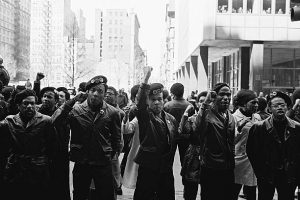
In the 1960s the fist salute became a symbol of Black-power militant groups in the US like the Black Panther Party which carried out armed citizens’ patrols to monitor police behavior in California. The Black Panthers would salute each other with raised fists. As well as raise their fists at rallies that solidified the symbol as synonymous with the fight for Black civil rights.
In May 1968, fists were raised at the Poor People’s Campaign in Washington, D.C., a multiracial effort conceived by Martin Luther King Jr. before his assassination to call for human rights for everyone living in poverty, regardless of race.
Does the raised fist mean the same in the 21st century? Yes, it does and its strong meaning is seen as protestors raised their clenched fists, in response to the police brutality experienced by people of color. The raised fist has become intertwined with the Black Lives Matter movement.
In August of 2016, Colin Kaepernick, NFL Quarterback, first protested by sitting down during the National Anthem. And in December of 2016, decided to kneel to protest racial and social injustice. Kaepernick’s
sit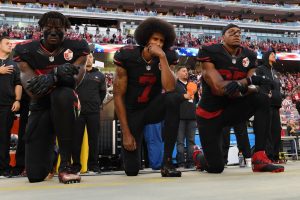 ting; kneeling and the Olympic fists are linked by History. Kaepernick lost his NFL career. If an ancestry DNA were to be performed, history’s DNA print would probably reveal that Kaepernick is a direct activist descendant of Smith and Carlos, unyielding in his conviction, and fully understanding the risk, sacrifice, and the power and dignity of a silent gesture.
ting; kneeling and the Olympic fists are linked by History. Kaepernick lost his NFL career. If an ancestry DNA were to be performed, history’s DNA print would probably reveal that Kaepernick is a direct activist descendant of Smith and Carlos, unyielding in his conviction, and fully understanding the risk, sacrifice, and the power and dignity of a silent gesture.
In May of 2016, a group of 16 female African-American cadets studying at the US military academy West Point took a photo on the steps of the academy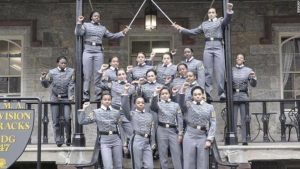 with fists raised to demonstrate unity and pride. They were cleared of charges that they violated any Army or Department of Defense regulations
with fists raised to demonstrate unity and pride. They were cleared of charges that they violated any Army or Department of Defense regulations
Beyonce’s performance at the NFL Super Bowl drew strong reactions. Dressed in black leather and black berets, the singer and dancers raised fists into the air during the show, mimicking the Black Panthers’ salute.
The Black fist on Tik Tok represents the Black Lives Matter movement. By changing their profile pictures, users are expressing their support and awareness of the movement’s cause.
Speaking Freely – Changing the Narrative
Fists are being raised often at protests around the world by Black and non-Black protesters. Whether taking a knee in the NFL, raising a fist while performing, or raising a fist on an Olympic podium, people continue to try to do the right thing by using their platforms for making social statements. Doing the right thing often means taking an unpopular position or putting one’s own safety on the line to protect another.
When you do the right thing, like Smith, Carlos, Kaepernick, and others have done, it may cost you your livelihood, reputation, your freedom, or your life. While doing my extended research that began with accidentally watching a documentary, I came across this statement – The thought of fear of reprisal or being ostracized is powerful enough to silence the strongest of us. But doing the right thing is the privilege of being able to act according to your conscience, of being able to speak up for others who do not have the same privilege.
I leave you with this: Maybe the fist does not require explanation. People simply feel it.











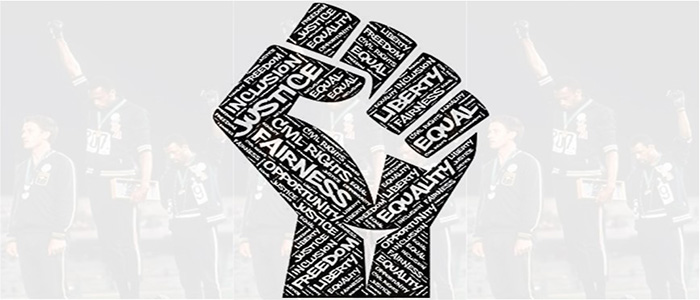


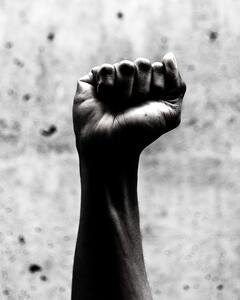



Add comment